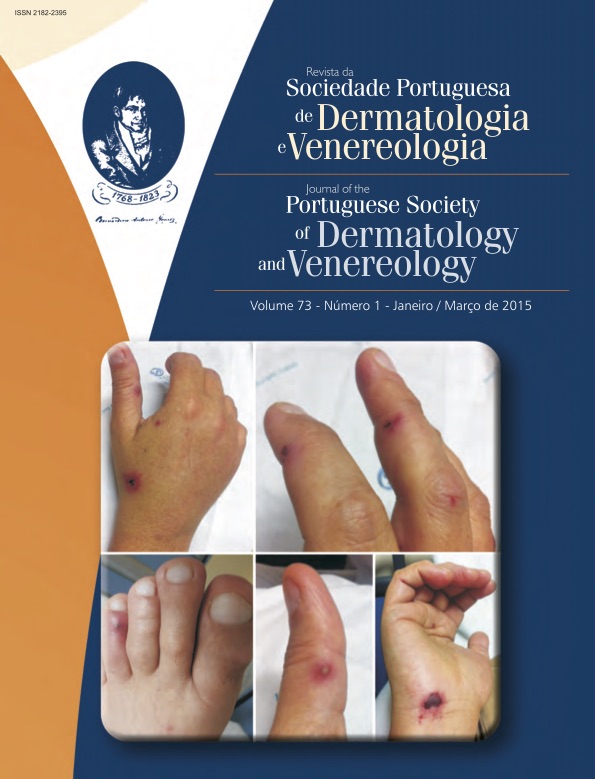VERRUGAS ANOGENITAIS NA CRIANÇA – UM DESAFIO DIAGNÓSTICO
Resumo
As verrugas anogenitais são tumores epiteliais benignos da pele e mucosas resultantes da infeção pelo papiloma vírus humano. Observa-se uma prevalência crescente na população pediátrica, na qual ocorrem por transmissão vertical, auto ou hetero-inoculação. O diagnóstico é clínico e a biopsia reserva-se para casos duvidosos. Na maioria há uma regressão espontânea mas a taxa de recidiva é elevada, mesmo sob terapêutica, pelo que a vigilância clínica é uma opção válida. A possível associação entre verrugas anogenitais e abuso sexual na criança constitui um desafio na prática clínica. A maioria dos autores considera que o diagnóstico de abuso depende fundamentalmente da qualidade da anamnese, da experiência dos profissionais envolvidos na avaliação e do exame objetivo da criança. É consensual que a probabilidade de abuso aumenta com a idade da criança, principalmente após os 5 anos. Abaixo dos dois anos a transmissão não sexual do papiloma vírus humano deve ser fortemente considerada na ausência de sinais traumáticos, de outra doença sexualmente transmissível ou de história consistente de abuso. Contudo, em nenhuma idade a hipótese de abuso sexual poderá ser excluída, requerendo um seguimento clínico com ponderação de todos os fatores mencionados.
Downloads
Referências
Sexually Transmitted Diseases Treatment Guidelines. MMWR. 2010;59:69-74.
Marcoux D, Nadeau K, McCuaig C, Powell J, Oligny LL. Pediatric anogenital aarts: a 7-year review of children referred to a tertiary care hospital in Montreal, Canada. Pediatr Dermatol. 2006; 23(3):199-207.
Sinclair KA, Woods CR, Sinal SH. Venereal warts in children. Pediatr Rev. 2011; 32:115-21.
Monk BJ, Tewari KS. The spectrum and clinical sequelae of human papillomavirus infection. Gynecol Oncol. 2007; 107(Supl1):S6-S13.
Syrjanen S. Current concepts on human papillomavirus infections in children. APMIS. 2010; 118(6-7):494-509.
Syrjanen S, Puranen M. Human papillomavirus infections in children: the potential role of maternal transmission. Crit Rev Oral Biol Med. 2000; 11(2):259-74.
Burns T, Breathnach S, Cox N, Griffiths C. Rook’s Textbook of Dermatology. 7th ed. Oxford: Blackwell Publishing; 2004.
Jones V, Smith SJ, Omar HA. Nonsexual transmission of anogenital warts in children: a retrospective analysis. Scientific World J. 2007; 7:1896-9.
Rombaldi RL, Serafini EP, Mandelli J, Zimmermann E, Losquiavo KP. Perinatal transmission of human papilomavirus DNA. Virol J. 2009; 6:83.
Obalek S, Jablonska S, Favre M, Walczak L, Orth G. Condylomata acuminata in children: frequent association with human papillomaviruses responsible for cutaneous warts. J Am Acad Dermatol. 1990; 23:205-13.
Obalek S, Jablonska S, Orth G. Anogenital warts in children. Clin Dermatol. 1997; 15:369-76.
Jayasinghe Y, Garland SM. Genital warts in children: what do they mean? Arch Dis Child. 2006; 91:696-700.
Bodemer C. Human papillomavirus infection. In: Harper J, Orange A, Prose N, editors. Textbook of pediatric dermatology. Oxford: Blackwell Science; 2000. p. 1087-9.
Smith EM, Parker MA, Rubenstein LM, Haugen TH, Hamsikova E, Turek LP. Evidence for vertical transmission of HPV from mothers to infants. Infect Dis Obstet Gynecol. 2010; 326369.
Jesus LE, Cirne Neto OL, Monteiro do Nascimento LM, Costa Araújo R, Agostinho Baptista A. Anogenital warts in children: sexual abuse or unintentional contamination? Cad. Saúde Pública. 2001; 17(6):138391.
Smith EM, Johnson SR, Cripe T, Perlman S, McGuinness G, Jiang D, et al. Perinatal transmission and maternal risks of human papillomavirus infection. Cancer Detect Prevent. 1995; 19(2):196-205.
Benjamin L, Levy M, Ofori A. Condylomata acuminata (anogenital warts in children). In: Basow, DS, editor. UpToDate. Waltham: UpToDate;2014. [consultado em Junho 2014]. Disponível em http://www.uptodate.com
Sterling JC, Handfield-Jones S, Hudson PM. Guidelines for the management of cutaneous warts. Br J Dermatol. 2001; 144:4-11.
Kellogg N. The evaluation of sexual abuse in children. Pediatrics. 2005; 116:506-12.
Fortin K, Jenny C. Sexual Abuse. Pediatr Rev. 2012; 33:19-32.
Sinclair KA, Woods CR, Kirse DJ, Sinal SH. Anogenital and respiratory tract human papillomavirus infections among children: age, gender, and potential transmission through sexual abuse. Pediatrics. 2005; 116(4):815-25.
Drezett J, Vasconcellos R, Pedroso D, Blake M, Oliveira A, Abreu L: Transmission of anogenital warts in children and association with sexual abuse. J Hum Growth Dev. 2012; 22(1):34-40.
Girardet RG, Lahoti S, Howard LA, Fajman NN, Sawyer MK, Driebe EM, et al. The epidemiology of sexually transmitted infections in suspected child victims of sexual assault. Pediatrics. 2009; 124(1):79-86.
Handley J, Hanks E, Armstrong K, Bingham A, Dinsmore W, Swann A, et al. Common association of HPV 2 with anogenital warts in prepubertal children. Pediatr Dermatol. 1997; 14:339-43.
Lacey CJN, Woodhall SC, Wikstrom A, Ross J. 2012 European guideline for the management of anogenital warts. JEADV. 2013; 27:e263-e270.
Fiorillo L. Therapy of pediatric genital diseases. Dermatol Ther. 2004;17(1):117-28.
Culton DA, Morrell DS, Burkhart CN. The management of condyloma acuminata in the pediatric population. Pediatr Ann. 2009; 38:368-72.
Ko J, Bigby M. Randomized controlled trial of cryotherapy with liquid nitrogen vs topical salicylic acid vs wait-and-see for cutaneous warts. Arch Dermatol. 2012; 148(7):840-2.
Le Cleach L, Trinquart L, Penso-Assathiany D, Chosidow O. Comparative effectiveness of cryotherapy and salicylic acid for plantar warts. Arch Dermatol. 2012; 148(11):1311-3.
Brandt H, Patriota R, Junior W, Fernandes J, Criado P. Tratamento do papiloma vírus humano na infância com creme de imiquimode a 5%. An Bras Dermatol. 2009; 84(5):549-53.
Moresi JM, Herbert CR, Cohen BA. Treatment of anogenital warts in children with topical 0.05% podofilox gel and 5% imiquimod cream. Pediatr Dermatol. 2001; 18:448-52.
Infarmed. Imiquimod – Resumo das Características do Medicamento (aprovado em 27/9/2012). [consultado 1 de Março 2014] Disponível em:http://www.infarmed.pt/infomed
Direção-Geral da Saúde. Programa Nacional de Vacinação 2012 – Norma nº 040/2011 de 21/12/2011. [consultado 23 abril 2014] [Disponível online em www.dgs.pt, acedido em 23 Abril 2014].
Howell-Jones R, Soldan, K, Wetten S, Mesher D, Williams T, Gill ON, et al. Declining genital warts in young women in England associated with HPV 16/18 vaccination: an ecological study. J Infect Diseases. 2013; 208:1397-403.
Todos os artigos desta revista são de acesso aberto sob a licença internacional Creative Commons Attribution-NonCommercial 4.0 (CC BY-NC 4.0).








